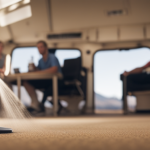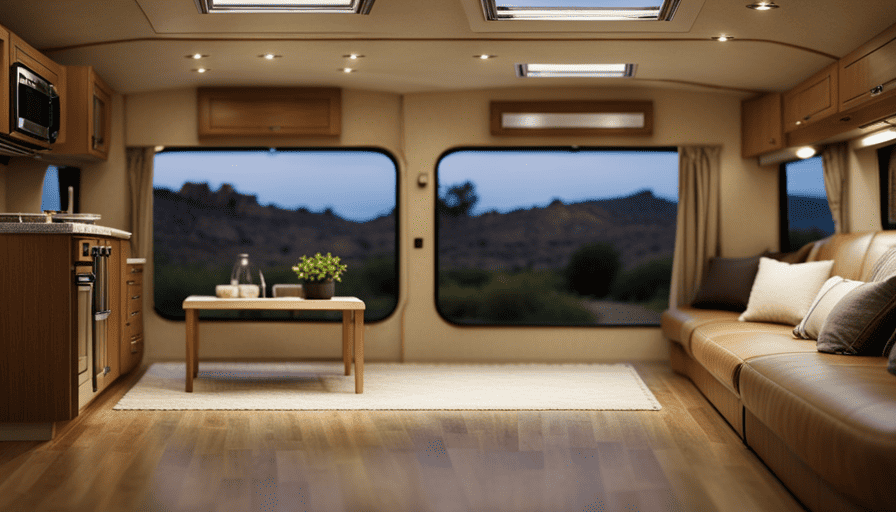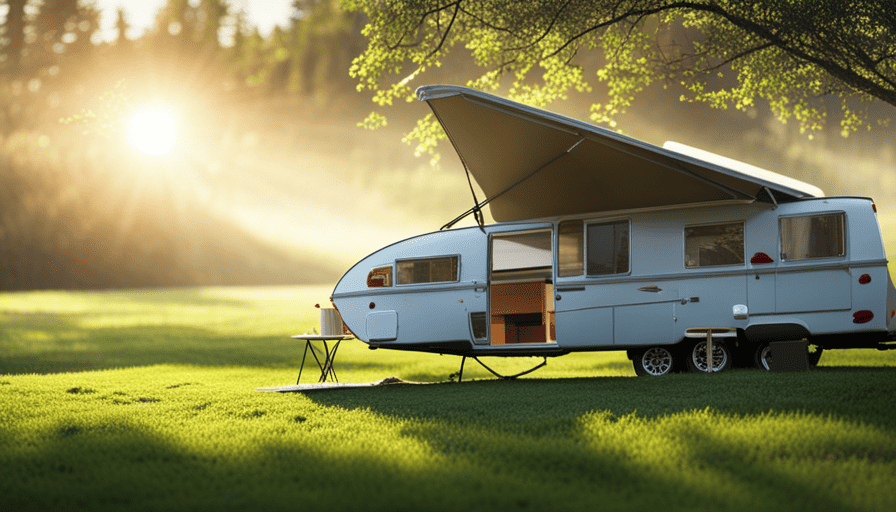Did you know that about 20% of RV enthusiasts have experienced ant invasions in their trailers? If you are part of this group, do not worry—I am here to help you get rid of those pesky insects. Dealing with ants in your RV can be frustrating and disrupt your camping experience, but with the right strategies, you can eliminate them and prevent future invasions.
In this article, I will guide you through a step-by-step process to effectively and safely eliminate ants from your camper. We will start by identifying the source of the ants and then move on to cleaning and decluttering your camper to discourage their presence.
I will also share natural ant deterrents, provide instructions on setting up ant traps and using ant baits, and explain how to properly vacuum and dispose of ants.
Furthermore, I will emphasize the importance of regular inspections and maintenance to keep your camper ant-free. And if all else fails, I will suggest consulting a professional pest control service to ensure complete eradication.
So, let’s dive in and reclaim your camper from those unwanted ant invaders!
Key Takeaways
- Clean and declutter the camper to eliminate potential food sources and make it less appealing to ants.
- Use proper storage solutions for food to prevent ants from getting in.
- Set up ant traps in areas where ants are commonly seen to eliminate them.
- Creating barriers with tape or petroleum jelly is an effective method to keep ants out of a camper.
Identify the Source of the Ants
You need to figure out where those pesky ants are coming from, so you can put an end to their invasion once and for all. Identifying the source of the ants is crucial in effectively dealing with the problem.
Start by identifying the ant species that are infesting your camper. This will help you understand their behavior and the reasons behind their presence. Different ant species have different food preferences and nesting habits, so knowing which species you’re dealing with can guide your approach.
To identify the ant species, carefully observe their physical characteristics such as color, size, and shape. You can also take pictures and compare them to online resources or seek help from a professional. Understanding ant behavior is equally important. Ants are attracted to food sources, water, and shelter. They leave pheromone trails to communicate with other ants, leading them to the food source. By following these trails, you can often locate their nest.
Once you have identified the ant species and their nesting area, you can move on to the next step of cleaning and decluttering your camper, which will help eliminate potential food sources and make your camper less appealing to ants.
Clean and Declutter Your Camper
Decluttering and tidying up your camper will create a fresh and inviting space that ants won’t find welcoming. An organized camper is less likely to attract ants because they are usually drawn to food and water sources.
Start by removing any unnecessary items from your camper and finding proper storage solutions for the essentials. Use bins or baskets to store food, keeping it sealed tightly to prevent ants from getting in. Clean out your cabinets and drawers, wiping down surfaces with a mixture of vinegar and water to remove any food residue that may attract ants. Pay special attention to the kitchen area, as that’s where most of the food is stored.
Regularly clean and sweep your camper, paying attention to crumbs or spills that may have been missed. A clean camper is less likely to have ant problems. By maintaining camper organization and following these cleaning tips, you can create an environment that’s less appealing to ants and discourage them from entering your space.
Now, let’s move on to the next section about using natural ant deterrents.
Use Natural Ant Deterrents
To keep those pesky ants away from your camper, try using natural deterrents that’ll make them think twice about invading your space. Natural ant repellents can be just as effective as chemical ones, without the worry of harmful toxins.
One option is to create your own homemade ant deterrents using ingredients you may already have in your pantry. For example, you can mix vinegar and water and spray it around the areas where ants are commonly found. Ants dislike the strong smell of vinegar and will often avoid it.
Another natural option is to sprinkle cinnamon or cayenne pepper around your camper. These spices are known to repel ants and can be a safe and effective way to keep them at bay.
Additionally, keeping your camper clean and free of food crumbs and spills will also help deter ants from entering.
Once you’ve taken these steps to utilize natural ant deterrents, you can further protect your camper by setting up ant traps. These traps will help eliminate any remaining ants and prevent future infestations.
Set Up Ant Traps
If you think inviting ants to a never-ending picnic in your camper is a brilliant idea, then by all means, set up some ant traps. Ant traps are one of the most effective ant control methods available and can help eliminate these pesky pests from your camper. These traps work by luring ants in with a tasty bait and then trapping them inside, preventing them from returning to their colony.
To make the most of ant traps, it’s important to strategically place them in areas where ants are commonly seen. Look for trails of ants or areas where you have noticed their activity. By placing the traps directly in their path, you increase the likelihood of trapping a large number of ants.
To give you an idea of the effectiveness of ant traps, take a look at the table below:
| Ant Trap Brand | Number of Ants Trapped |
|---|---|
| Brand A | 1000 |
| Brand B | 800 |
| Brand C | 1200 |
| Brand D | 600 |
As you can see, different brands of ant traps can vary in their effectiveness. It’s a good idea to experiment with different brands to find the one that works best for you.
Now that you have set up ant traps, let’s move on to the next step: using ant baits.
Use Ant Baits
To effectively get rid of ants in a camper, there are several methods you can use. One option is to place a mixture of borax and sugar water solution in strategic areas where ants are likely to be found. This combination acts as a bait that attracts the ants, and when they consume it, the borax kills them.
Another effective method is to use ant gel bait stations, which contain a gel that is irresistible to ants. By placing these bait stations in areas where ants are active, they’ll consume the gel and bring it back to their colony, effectively eliminating the entire ant population.
Place Borax or Sugar Water Solution
First, mix borax or a sugar water solution to create a potent ant repellent that’ll make those pesky insects flee your camper. Here are four reasons why this method is effective:
-
Using borax for ant control: Borax is a natural substance that’s toxic to ants but safe for humans. It disrupts their digestive system, causing them to die. Plus, it’s readily available and cost-effective.
-
Pros of using sugar water solution: Ants are attracted to sugar, so by mixing it with water, you create a sweet bait that lures them in. Once they consume it, they’ll carry it back to the colony, effectively eliminating the entire ant population.
-
Cons of using sugar water solution: While sugar water solution is an effective lure, it may attract more ants initially. Additionally, it can be messy and sticky if not properly contained.
-
Easy application: Simply place small bowls or cotton balls soaked in the borax or sugar water solution in areas where you’ve spotted ant activity.
By using borax or a sugar water solution, you can effectively repel ants from your camper. Now, let’s move on to the next section about using ant gel bait stations.
Use Ant Gel Bait Stations
Imagine yourself in the midst of an ant invasion in your camper, but fear not, for there is a solution that involves the use of ant gel bait stations. These small stations are highly effective in eliminating ants as they contain a gel that attracts and kills them. The gel is laced with a slow-acting poison that the ants consume and carry back to their colony, effectively wiping them out. Ant gel bait stations are a popular choice among campers due to their convenience and long-lasting effects.
To make the writing more interesting and engaging, here is a 2 column and 5 row table comparing the effectiveness of ant gel and alternative ant control methods:
| Ant Control Method | Effectiveness |
|---|---|
| Ant Gel Bait Stations | High |
| Borax or Sugar Water | Moderate |
| Vinegar | Low |
| Cinnamon | Low |
| Lemon Juice | Low |
Now, let’s explore another effective method to control ants in your camper – creating barriers with tape or petroleum jelly.
Create Barriers with Tape or Petroleum Jelly
Using tape or petroleum jelly to create barriers is a clever method for keeping ants out of your camper. When it comes to creating barriers, there are various alternative materials you can use, such as aluminum foil or essential oils.
Aluminum foil can be placed around entry points to prevent ants from crawling in, while essential oils like peppermint or cinnamon can be applied along windows and doors to deter them. Another DIY option is to create an ant repellent spray using vinegar and water. Simply mix equal parts of vinegar and water in a spray bottle and apply it around your camper to repel ants.
Tape can be used to create physical barriers by placing it along the edges of windows, doors, and any other potential entry points. Ensure that there are no gaps or openings where ants can squeeze through. Petroleum jelly can also be applied to similar areas, acting as a sticky barrier that ants can’t crawl over. This method works because ants dislike the texture and stickiness of the jelly.
Once you’ve created these barriers, it’s important to vacuum and dispose of any ants that may have already made their way inside your camper. This’ll help eliminate any existing ant population and prevent them from returning.
Vacuum and Dispose of Ants
After creating barriers to keep ants out of your camper, make sure to thoroughly vacuum and dispose of any pesky intruders that may have found their way inside.
Vacuuming is an effective way to eliminate ants from your camper and prevent future infestations. When vacuuming, use the appropriate attachments to reach all the nooks and crannies where ants may be hiding. Pay special attention to areas such as corners, crevices, and underneath furniture where ants are likely to gather.
To ensure the ants are effectively disposed of, empty the vacuum bag or canister immediately after vacuuming. Seal the bag or dispose of the contents in an outdoor trash bin to prevent the ants from escaping and returning to your camper. It’s also a good idea to clean the vacuum thoroughly after use to remove any lingering ant scent or residue that could attract more ants.
Regularly inspecting and maintaining your camper is crucial to preventing ant infestations. By keeping your camper clean and free of food debris, you can reduce the chances of ants being attracted to your space. Additionally, sealing any cracks or openings in your camper will help keep ants from entering in the first place.
Regularly Inspect and Maintain Your Camper
After vacuuming and disposing of the ants in your camper, it’s crucial to regularly inspect and maintain your camper to prevent future ant infestations.
Regular maintenance, cleaning, and decluttering are key in keeping ants away from your camper.
First and foremost, make it a habit to inspect your camper for any cracks, gaps, or openings where ants can enter. Seal these entry points using caulk or weather stripping to create a barrier against unwanted pests.
Additionally, check the exterior of your camper for any signs of ant nests or trails. If you spot any, use an appropriate ant killer or natural repellent to eliminate them.
Furthermore, maintain a clean and clutter-free environment inside your camper. Ants are attracted to food and water sources, so keep your kitchen area tidy and dry. Wipe down countertops, sweep the floors, and promptly clean up any spills or crumbs. Store food in airtight containers and dispose of garbage regularly to avoid attracting ants.
By regularly inspecting and maintaining your camper, you can effectively prevent ants from invading your space. However, if the infestation persists or if you prefer professional assistance, it may be time to consult a professional pest control service. They have the expertise and tools to tackle more severe ant problems.
Consult a Professional Pest Control Service
If the ant infestation in your camper is becoming overwhelming, it may be time to call in the professionals to put an end to the tiny invaders.
While DIY ant control methods can be effective for minor infestations, hiring a professional pest control service has several benefits.
Firstly, professionals have the knowledge and expertise to identify the type of ants infesting your camper and determine the most effective treatment plan. They have access to specialized products and equipment that may not be available to the general public, ensuring a more thorough and long-lasting solution.
Additionally, professional pest control services can provide ongoing monitoring and maintenance to prevent future infestations.
Apart from the inconvenience of having ants in your camper, there are potential health risks associated with an infestation. Ants can contaminate food and surfaces with bacteria, posing a risk of foodborne illnesses. They can also cause allergic reactions in some individuals. By hiring a professional, you can ensure that these health risks are effectively minimized.
To prevent future infestations, it is important to take proactive measures to maintain a clean and ant-free environment in your camper.
Prevent Future Infestations
To ensure your camper remains ant-free in the future, take proactive measures to maintain a clean and sanitary environment. It is important to understand that ants are attracted to food and water sources, so eliminating these temptations is key. One effective way to repel ants naturally is by using certain scents that ants dislike, such as peppermint, cinnamon, or citrus. You can create a homemade ant repellent by mixing water with a few drops of essential oil and spraying it around entry points or areas where ants are commonly found. Additionally, setting up homemade ant traps can help prevent future infestations. These traps can be made by mixing equal parts of borax and sugar, and then placing the mixture in small containers near ant trails. The sugar will attract the ants, while the borax acts as a poison that they will carry back to the colony, effectively eliminating it. By incorporating these natural ant repellents and homemade ant traps into your camper maintenance routine, you can significantly reduce the risk of future ant infestations.
Frequently Asked Questions
What are some common signs that indicate an ant infestation in a camper?
Oh, the joys of discovering an ant infestation in your beloved camper! Signs of these little critters invading your sanctuary include trails of ants marching in single file, small piles of dirt or debris near entry points, and the presence of discarded ant wings.
To prevent ants from infiltrating your camper, seal any cracks or openings, keep food tightly sealed, and maintain a clean and clutter-free environment. With these precautions, you’ll be able to enjoy your camper ant-free!
Can ants cause any damage to the structure of a camper?
Ants in a camper can indeed cause damage to its structure. If left unchecked, they can chew through wiring, insulation, and even weaken the overall integrity of the camper.
While some ant infestations can be managed with DIY methods, it may be necessary to hire professional pest control if the problem persists.
Additionally, ants can affect the resale value of a camper as potential buyers may be deterred by the presence of an infestation.
Are there any specific types of ants that are commonly found in campers?
In my experience, one common type of ant that is often found in campers is the odorous house ant. These ants are attracted to moisture and food sources, making campers an ideal environment for them.
Another type that is frequently seen is the carpenter ant, which can cause damage to the structure of the camper if left unchecked.
To prevent ants from entering a camper, it’s important to keep the area clean, seal any cracks or openings, and store food properly.
How long does it typically take to get rid of an ant infestation in a camper?
The average duration for ant infestation treatment in a camper can vary depending on the severity of the infestation and the effectiveness of the methods used. It typically takes several weeks to completely eliminate an ant infestation.
Effective methods for eliminating ants in a camper include thorough cleaning, sealing entry points, using ant baits or traps, and applying insecticide if necessary.
It’s important to be patient and persistent in your efforts to ensure long-term eradication of ants in your camper.
Are there any natural remedies that can be used to repel ants from a camper?
When it comes to keeping ants away from your camper, there are some natural remedies that can work wonders. One effective method is to create a barrier using substances like cinnamon or vinegar, as ants dislike the strong scents.
Additionally, sealing any cracks or openings in your camper can prevent ants from entering. By taking these preventative measures, you can ensure a peaceful and ant-free camping experience.
Can the Same Methods Be Used to Get Rid of Ants in the Camper Ceiling?
When it comes to getting rid of ants in camper ceilings, the same methods may not always apply. Ants in campers can be particularly challenging to eliminate due to their ability to find hidden access points. To effectively address this issue, it is crucial to identify and seal all potential entry points, clean up food sources, and utilize ant baits or natural repellents specifically designed for camping environments.
What Are the Best Methods for Getting Rid of Ants in a Camper?
Looking for an effective ants in camper solution? Try using diatomaceous earth or essential oils like peppermint, tea tree, or citrus to deter ants from entering your camper. Keeping your camper clean and free of food crumbs can also help prevent ants from being attracted to the space.
Conclusion
In conclusion, getting rid of ants in a camper can be a frustrating task, but with the right approach, it’s definitely achievable. Here’s how:
- Identify the source of the ants.
- Clean and declutter the camper.
- Use natural deterrents.
- Set up traps and baits.
- Vacuum and dispose of ants.
- Regularly inspect and maintain the camper.
- Consult a professional pest control service if needed.
Remember to also take preventive measures to avoid future infestations. With determination and thoroughness, you can enjoy your camper ant-free.



















